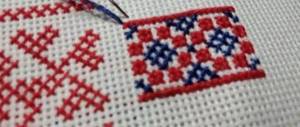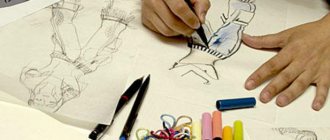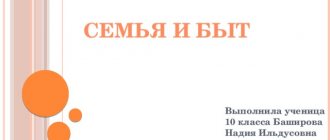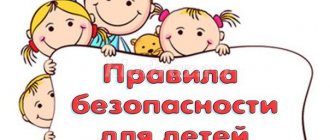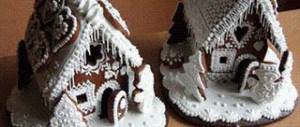Cross stitch (presentation) presentation for a technology lesson on the topic
Slide 1
Cross stitch The presentation was prepared by technology teacher MBOU Krasnopoimskaya Secondary School Poluyanova Irina Vladimirovna
Slide 2
Purpose: To acquaint students with the history of embroidery, talk about the features of cross stitch. Develop an interest in this type of needlework. To cultivate aesthetic taste, a sense of beauty, and respect for Russian folk traditions.
Slide 3
Embroidery is one of the most beloved and widespread types of needlework. The history of its origin goes back centuries. At different times, the materials for embroidery were animal sinews, threads of flax, hemp, cotton, wool, silk, and natural hair was also used.
Slide 4
In our country, since ancient times, embroidery has been used to decorate clothes, shoes, horse harnesses, homes, and household items.
Slide 5
The best preserved items are from the 19th century. In those days, embroidery was conventionally divided into urban and peasant (folk). Urban embroidery was influenced by Western fashion and did not have strong traditions. Folk culture was inextricably linked with the ancient customs and rituals of the Russian peasantry.
Slide 6
By the age of 13-15, peasant girls had to prepare a dowry for themselves: embroidered tablecloths, valances, hats, towels. Before the wedding, a public display of the dowry was held as evidence of the bride’s hard work and skill. The bride presented the groom's relatives with her products.
Slide 7
In peasant families, clothes were made from homespun linen and woolen fabrics. It was decorated not only with embroidery, but also with lace, braid, and colored chintz inserts.
Slide 8
Since pagan times, women embroiderers have created scenes of everyday life in their embroidery paintings. Most often, embroidery was used to decorate bed sheets (sheets), the ends of which hung from the beds, as well as towels, tablecloths, curtains, wedding and holiday shirts, canvas sundresses, hats, and scarves.
Slide 9
In Christian times, the custom arose of decorating icons, mirrors and windows with embroidered towels. At a wedding, Maslenitsa, at the birth or death of a person, embroidered towels were a sacred amulet.
Slide 10
Originating in antiquity, the art of embroidery has been constantly improved over many centuries. Over time, individual figures changed, became more complex, and were combined with other forms, creating patterns. This is how ornaments arose - the sequential repetition of individual patterns or a group of them.
Slide 11
Modern options for the arrangement of ornaments on a particular product depend on its purpose, size and shape.
Slide 12
The cross is one of the easiest types of embroidery to master. Interesting geometric patterns can be easily embroidered with a cross. The cross belongs to the counted types of embroidery. It is used to embroider on fabrics on which it is easy to count the threads.
Slide 13
The most common embroidery is a simple cross stitch - when the stitches are located along the diagonal lines of the cell and intersect in the center.
Slide 14
There are many options for cross stitch: Half cross Extended cross Extended cross with stitching Slavic cross Double cross Star cross Leviathan cross (Bulgarian) Rice stitch
Slide 15
Over the centuries, embroiderers have experimented with suitable materials, developing and improving their art, drawing inspiration from the world around them, from art, and from ornaments of other times and cultures. Fashion for various types of embroidery appears and disappears, but the main types remain unchanged.
Slide 16
Sources of information: Ivanova A.A.: Hand embroidery: - Moscow, Academy, 2007. Rozman G.I.: I embroider pictures with a cross. - M., 2006. Materials from the site www.vishivka-st.ru Materials from the site ru. wikipedia. org Pictures from the resource www.yandex.ru
presentation “Types of embroidery” presentation for a technology lesson on the topic
Slide 1
Types of embroidery
Slide 2
Embroidery is the decoration of various materials or finished products with ornaments or plot designs using threads (silk ribbons, beads and other materials) and a needle (embroidery machine). Since ancient times, embroidery has been one of the most beloved and widespread types of folk arts and crafts in Rus'. All women, young and old, mastered this art perfectly. Embroidery was based on ancient rituals and customs. This is especially true for cross stitch. The cross has always been considered by the Russians as a talisman that can protect a person and his home from evil spirits and the evil eye. Historical reference
Slide 3
Initially, embroidery in Rus' was an activity for the elite. Until the seventeenth century, it was practiced by nuns and members of the nobility. The materials were expensive fabrics such as velvet and silk, precious stones, pearls, gold and silver threads. Since the 17th century, this type of needlework has been included in the category of compulsory activities for peasant girls. Starting from the age of seven or eight, girls began to prepare their dowry for the wedding. It was necessary to embroider tablecloths, bedspreads, towels, tablecloths, as well as various clothes. It was also customary to embroider special gifts for the groom's relatives and guests. On the eve of the wedding, an exhibition of the prepared dowry was held in front of all the honest people, this helped everyone to appreciate the skill and hard work of the bride. Historians divide Russian peasant embroidery into two categories, based on geographical characteristics. The embroidery of the Central Russian strip is characterized by the use of threads of different colors and a variety of fabrics that could act as pattern elements. Embroidery of the northern regions is characterized by the use of mainly red threads and white fabric. Or vice versa. The development of Russian embroidery was greatly influenced by Byzantine needlework. Therefore, in the works of the craftswomen, native Russian motifs are combined with the heritage of foreign embroidery schools.
Slide 4
“cross” “Bulgarian cross” satin stitch Chain stitch Stitching stitch Drawstring stitch Goat stitch Buttonhole stitch Types of embroidery:
Slide 5
Buttonhole overcasting
Slide 6
Loop stitches are used when sewing welt stitches and making thread loops. When sewing a loop, the needle is inserted into the fabric from below at a small distance from the sections (0.2-0.4 cm depending on the thickness of the fabric); then the thread coming from the eye is thrown over the end of the needle from left to right, and the resulting loop is tightened. The tightening of all stitches should be even. The stitches are laid from left to right at equal distances from one another.
Slide 7
Seam "forward needle"
Slide 8
This seam is made with even, straight stitches, as if resembling a dotted line. The direction of this seam is from right to left. The needle is inserted into the fabric and brought up, while the distances between the stitches should be the same.
Slide 9
Chain stitch
Slide 10
Seam "Goat"
Slide 11
Successful work!
